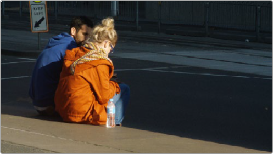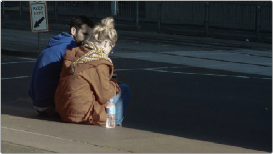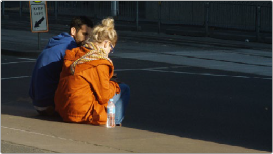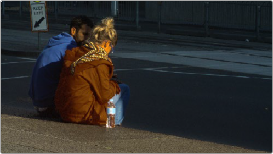

< Previous | Contents | Next >
The Hue vs. Sat curve lets you selectively alter the saturation of any hue within the image. This is a terrific tool for creative effect, allowing you to quickly and easily boost the saturation of elements you want to catch the viewer’s eye, while reducing the saturation of elements you’d prefer the audience not dwell upon.
This can be extremely useful for legalizing over-saturated overshoots or undershoots during
a QC pass. For example, desaturating reds that are off the charts while leaving everything else alone.


Lowering the saturation of the woman’s jacket using the Hue vs. Sat curve; Left–original image, Right–altered image
The Hue vs. Sat curve can also be a powerful tool for increasing the color contrast of images that seem lackluster and flat. By boosting the saturation of colorful elements that are distinct from the dominant palette of a scene, you can add variety to an otherwise monochromatic image.
Hue vs. Lum
The Hue vs. Lum curve lets you increase or decrease the lightness of elements of specific colors.


![]()
Darkening the woman’s jacket using the Hue vs. Lum curve; Left–original image, Right–altered image
This is a tricky curve to use with highly compressed footage, as it can quickly reveal artifacts in the image if you aren’t careful. However, if you’re working with very high-quality footage, this can be a great tool to darken specific hues to add richness and depth, or to lighten colorful elements to which you want to draw attention.